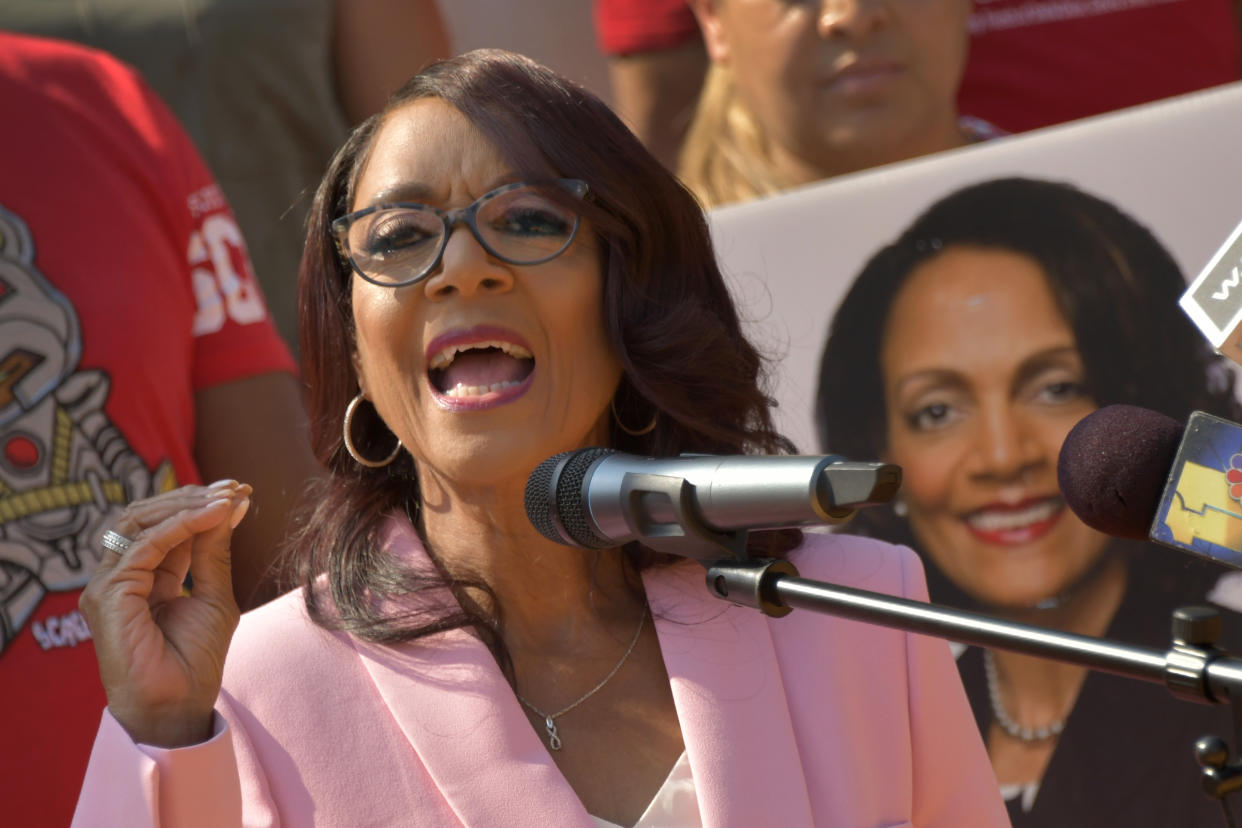Baltimore mayoral candidate Sheila Dixon unveils crime plan calling for improved police recruitment

- Oops!Something went wrong.Please try again later.
- Oops!Something went wrong.Please try again later.
Former Baltimore mayor and current mayoral candidate Sheila Dixon unveiled a plan Thursday to combat crime in Baltimore, recommending a return to strategies she credits for lower crime rates during her time in office.
The plan, which Dixon rolled out at a news conference at a West Baltimore recreation center, calls for increased police recruitment efforts, expanded intelligence gathering through community intervention programs and a strong push on state and federal officials to better fund juvenile justice systems.
“Baltimoreans don’t feel safe in their own communities,” said Dixon. “We need to raise our expectations, Baltimore, and we need to be accountable from the mayor.”
Dixon is hoping to oust Mayor Brandon Scott who is serving his first term in office. Both are Democrats. She will also face former prosecutor Thiru Vignarajah and businessman Robert Wallace in the Democratic primary on May 14.
Mayor of Baltimore from 2007 to 2010 before she was forced from the post by a scandal, Dixon shepherded the city during a period of historically low homicide rates. The annual homicide count dropped from 282 to 238 during her time in office, and the violent crime rate went down each year. Arrests declined from a high under her predecessor, Democrat Martin O’Malley, when “zero-tolerance” policies were still in place.
Dixon repeatedly harkened back to that period Thursday, arguing the crime reduction was a product of her ability to select the right people for the right positions. Shortly after taking office, Dixon appointed a police commissioner from within the department who emphasized targeted arrests of violent shooters.
Today, the Baltimore Police Department is suffering from too many vacancies, Dixon said Thursday, making it difficult for existing members to engage with the city residents they serve.
In the last four years, Baltimore has offered a signing bonus to new police officers and has contracted for recruitment efforts, however vacancies have persisted. As of June, the police department had 522 vacant positions, 338 of which were vacant jobs dedicated to patrol.
“Mayor Scott has failed to recruit police officers like he failed to recruit sanitation workers and workers across city agencies,” Dixon said. “This is about management. It’s about implementation.”
If elected, Dixon said she would reevaluate eligibility requirements to join the department and promote public safety jobs to students in city schools. To supplement the force, Dixon said she would create part-time contractual positions for retired police officers.
As a strategy, Dixon said she supports the focused deterrence model, which would attempt to identify violent offenders and offer social supports in an effort to redirect them. In a written plan distributed to media, Dixon said the model has proven “extremely effective” but is “resource intensive.”
“As Mayor, we will collect and analyze intelligence to determine where to utilize this strategy to maximize results,” the plan states.
During his time in office, Scott has implemented a similar program known as the Group Violence Reduction Strategy. The approach aims to intercept people more vulnerable to becoming shooters or victims. Those people are offered social supports and are connected with community members to impress upon them the risks involved.
The program, which began as a yearlong pilot in the city’s Western District, has since been expanded.
Dixon said Thursday she was not “married” to keeping the Group Violence Reduction Strategy in place. She said she would assess the program and see if there worthwhile elements that could be built upon.
“One thing I don’t believe in is playing the numbers, and I know there are other efforts going on in West Baltimore as well,” she said of the strategy’s pilot.
Dixon said she would take a similar approach to the Mayor’s Office of Neighborhood Safety and Engagement which leads many of the more holistic public safety efforts of the Scott administration, including the Group Violence Reduction Strategy.
“We need to look at MONSE because of where the funding is, where the grants are coming from and what changes we need to make,” Dixon said.
The former mayor’s plan called for “reinstituting” several programs that are still in existence, including CompStat and CitiStat, data-tracking programs that city leaders use to inform and guide decisions about crime fighting and broader city services. Dixon’s plan also calls for the reinstitution of the Criminal Justice Coordinating Council, a group of city, state and federal law enforcement agency leaders who meet periodically to discuss public safety.
Republican Gov. Larry Hogan defunded the council in 2017 after city judges refused to meet with him to discuss public safety. However, Scott reconvened the group in 2021, absent the judges who previously sat on the panel.
Dixon acknowledged Thursday that the group has been meeting.
“I know the administration will say that it exists, but it doesn’t exist in the framework that is most effective,” she said. “You’ve got to put it at a neutral place with all the judges at the table.”

